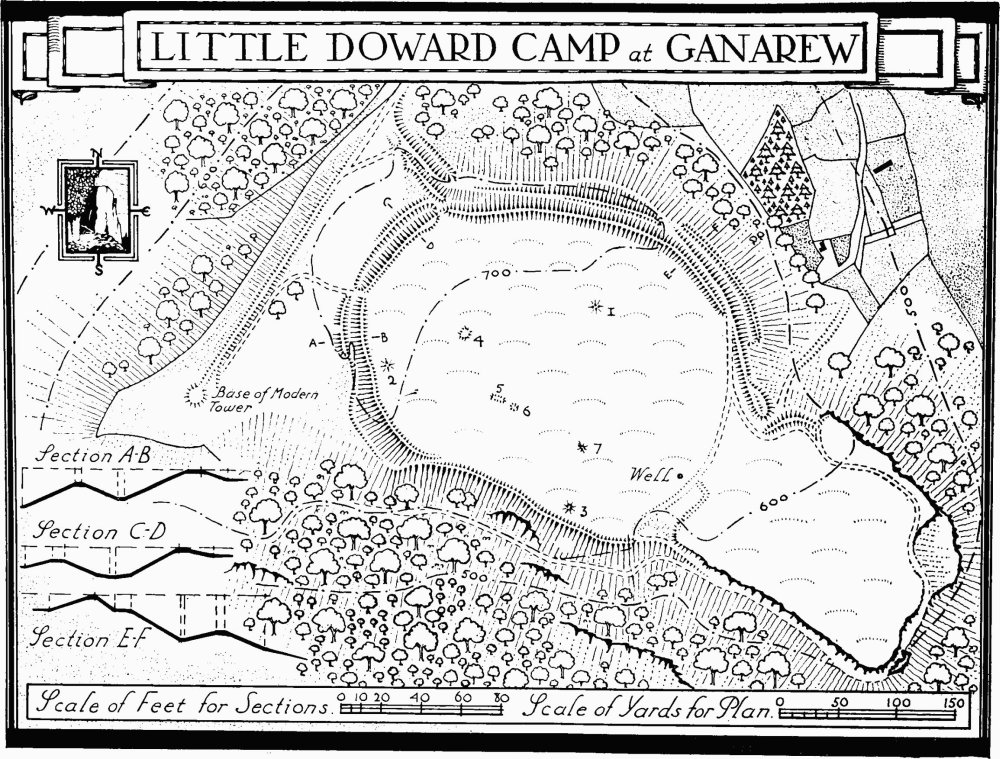Pages 68-69
An Inventory of the Historical Monuments in Herefordshire, Volume 1, South west. Originally published by His Majesty's Stationery Office, London, 1931.
This free content was digitised by double rekeying and sponsored by English Heritage. All rights reserved.
In this section
27 GANAREW (D.e.)
(O.S. 6 in. LIV, S.W.)
Ganarew is a parish on the right bank of the Wye, 7 m. S.W. of Ross. Little Doward Camp is the principal monument.
Ecclesiastical
(1). Parish Church of St. Swithin, was entirely re-built in 1850, but the churchyard contains the following:—
Fitting—Monument: S. of chancel, to Henry Fisher, 1710, and Anne his wife, 1710, headstone.
Unclassified

Little Doward Camp at Ganarew
(2). Little Doward Camp, on the top of Little Doward Hill, ½ m. E.S.E. of the church, is of the hilltop type, with a steep fall in all directions, especially on the S. towards the River Wye. The area with the defences is about 26 acres not including the outwork on the N.W. which is probably modern. The earthworks were considerably damaged early in the 19th century when the owner formed paths through the ramparts and is said to have replaced an outer rampart on the N.W. by the straight bank leading to an iron viewtower. The camp now consists of an oval enclosure with a rectangular annexe towards the S.E. The oval portion is surrounded by a double embankment with a medial ditch, except on the S. side where the steep slope made only a single bank necessary; the double embankment turns outward at the N.W. angle indicating the former existence of an outer enclosure on this side. The rectangular annexe is only defended by a natural outcrop of rock on three sides; it is divided from the main camp by a track which is partly sunk. There are four entrances—(1) at the N.W. angle where the rampart is prolonged; (2) on the N.E. angle where the oval and rectangular parts of the camp meet; the rampart here is turned inwards on the S.E. side; (3) at the corresponding point on the other side of the rectangular annexe there are traces perhaps indicating another entrance; (4) at the S. angle of the annexe an entrance has been cut through the rock, but this may possibly be modern. Within the oval area are a well and a series of mounds as follows, (1) round and 42 ft. in diam., 4 ft. high and with traces of a surrounding ditch; (2) round and 34 ft. in diam., 4½ ft. high and with traces of a surrounding ditch; (3) rectangular, 33 ft. by 27 ft. and about 2½ ft. high with traces of a surrounding ditch; (4) rectangular, 39 ft. by 36 ft. and 2½ ft. high with traces of a ditch; (5) rectangular, 39 ft. by 18 ft. and about 2 ft. high; S.E. of it is a sinking about 5 ft. deep (6); (7) faint traces of a mound 21 ft. in diam. and 9 in. high in the middle; (5) and (6) are perhaps modern.
Condition—Ramparts much damaged.


